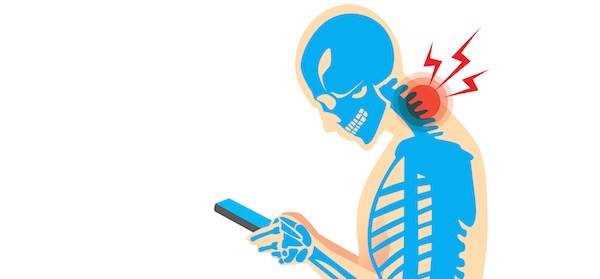How long do you spend on your phone each day? Maybe you’re reading this article on your smartphone right now? The average smartphone user is spending two-to-four hours per day with their head in a downward and forward position, and ‘text neck’ is certainly on the rise.
The average head weighs between six and eight kilograms. However, as you angle your chin towards your chest, the effective weight gradually increases to the point where a 60-degree tilt of the neck can result in a three- or four-fold weight increase.
In a normal standing or sitting position all the curves of the neck and spine are in alignment, with the weight of the head supported by the natural curves of the spine. With the head in a downward position for long periods, structures in the neck are stretched, overloaded and squashed. Combined with a sedentary lifestyle, this can lead to excessive wear and tear that leads to symptoms including headache, neck pain, arm pain and even numbness.
A simple strategy to combat ‘text neck’ is to improve your posture. Try moving the phone towards eye level rather than tilting your neck downwards. Whilst not ideal, reducing the angle of your neck can significantly reduce the effective weight and load on neck structures. Frequent breaks between phone tasks can also help. Ensure that you look forwards at least every 10–15 minutes when using your phone. To prevent asymmetry, use two hands when texting, or try alternating hands. Using voice commands and voice-to-text can also reduce the amount of time spent looking downwards.
Stretching and general exercise can also combat ‘text neck’. When combined with other sitting postures throughout the day, such as using the computer, reading or watching television, there are large amounts of stress placed through the upper spine. Stand up frequently and squeeze your shoulder blades together. This simple stretch can alleviate stress and muscle pain. This exercise can be repeated as many times as practical throughout the day, but a good starting point is to do four-to-six squeezes every waking hour.
If you are experiencing any symptoms associated with ‘text neck’, then get assessed by your physiotherapist. Your physiotherapist will be able to recommend a series of exercises to help strengthen your neck and upper back muscles. They will also come up with a comprehensive treatment plan to resolve your symptoms as quickly as possible, which may include joint mobilisations, soft tissue work and a range of exercises dependent on your symptoms.
Jason Lee APAM
B. Physiotherapy
Malvern East Physiotherapy
Jason is happy to answer any questions you may have simply send an email to [email protected]
Related articles:
How to manage knee osteoarthritis
Is Pilates good for foot drop?

